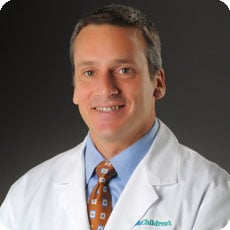Positional plagiocephaly
While minor head asymmetries can be common in the neonate world, significant shifts in the skull shape must be assessed in order to rule out pathology that could have long-term effects. The key to differentiating positional plagiocephaly from craniosynostosis still rests in the physical exam. Always look for torticollis, for this can be a major contributor to positional plagiocephaly.
Signs of craniosynostosis:
- Suture ridging
- Trigonocephaly
- Scaphocephaly
- Inappropriate growth of the head size (too little)
Signs of plagiocephaly:
- The sutures will be flat and the anterior fontanel will be open
- The ear on the affected side (i.e., the flattened occiput) is anterior to the ear on the non-affected side
- The ipsilateral forehead shows a more acute angle while the contralateral forehead demonstrates a more obtuse angle
- At times, a tricky positional plagiocephaly may need plain films in order to assess the patency of the cranial sutures. Generally, an antero-posterior (AP), lateral, and Townes view will suffice but a CT scan of the skull remains the diagnostic standard when working up the cranial skeleton.
Differential diagnoses
- Metopic synostosis: Trigonocephaly (triangular forehead) with hypotelorism
- Sagittal synostosis: Long cranium with frontal bossing, saddle-shaped parietal region and a narrow occiput (scaphocephaly)
- Coronal synostosis: Unilateral or bilateral forehead flattening with a harlequin or open eye on the ipsilateral side
- Lambdoid synostosis: Unilateral occipital flattening with the ipsilateral ear posterior to the contralateral ear
Treatment
If there is no sutural ridging and no indication of craniosynostosis, the age-old concept that a baby may grow out of it, still holds true. Simple repositioning so the baby lays on the more angular occiput may help to correct the problem.
Remember, the cause of the asymmetry was too much pressure on one side. By repositioning on the opposite side we hope to reverse the trend.
There are a few variables to consider when counseling the family of a baby with positional plagiocephaly. First, neonates have proportionally big heads and weak necks. Why is this relevant? It is important because a neonate with a flattening of one occiput will preferentially lie on its flat spot because it takes less effort to keep the head in one position.
Consider a ball with a flat spot. Roll it across the floor and it will stop on the flat spot more frequently than the round side. The problem with lying on the flat spot brings us back to the cause of the problem — outside pressure. If a child lies on the affected side more that the non-affected side, the symptoms will worsen because of the pressures focused on the flat spot.
To correct the issue, we need to allow forces to work in the opposite direction. But it is not so easy to maintain a child lying in one position and on a point. A bolster will help, but if your child is like my children, they are active sleepers who can cover a few miles a night; therefore, with the best of intentions, positioning may not help.
After a month, the next step is a headband or helmet. To begin with, headbands do not load or pressure the skull. If you have a child in a band and he or she has red pressure spots, the band should be adjusted.
Bands work on two fronts: First, each band is custom made to fit the neonate head after which internal foam is removed in the areas of desired growth. The head then reshapes itself by passively growing into the open slot. Secondarily, the helmet holds the skull in a cradle so that no matter how a child lies, no extra pressure is placed on the flat spot. If the headband is worn 23 hours a day, the head slowly restores a rounded shape.
If uncomfortable diagnosing or if improvement is not seen after these efforts, please consider referring to the Cook Children’s Craniofacial and Cleft Surgery department.
Get to know Eric Hubli, M.D.
 Dr. Hubli brings 25 years of Craniofacial, Cleft and Pediatric Plastic Surgery experience to Fort Worth, Texas and the Cook Children's Healthcare System. Cook Children's Cleft, Craniofacial and Plastic Surgery team specializes in plastic and reconstructive surgery for children with face, head and neck conditions. As the Medical Director of Craniofacial and Cleft Surgery, Dr. Hubli's practice is unique in that it focuses exclusively on children with reconstructive, craniofacial and cleft issues. Understanding that kids are not “little adults” and that pediatric issues involve not just the patient but the entire family Dr. Hubli has tailored his practice to meet the broad set of issues that this holistic approach requires."
Dr. Hubli brings 25 years of Craniofacial, Cleft and Pediatric Plastic Surgery experience to Fort Worth, Texas and the Cook Children's Healthcare System. Cook Children's Cleft, Craniofacial and Plastic Surgery team specializes in plastic and reconstructive surgery for children with face, head and neck conditions. As the Medical Director of Craniofacial and Cleft Surgery, Dr. Hubli's practice is unique in that it focuses exclusively on children with reconstructive, craniofacial and cleft issues. Understanding that kids are not “little adults” and that pediatric issues involve not just the patient but the entire family Dr. Hubli has tailored his practice to meet the broad set of issues that this holistic approach requires."
